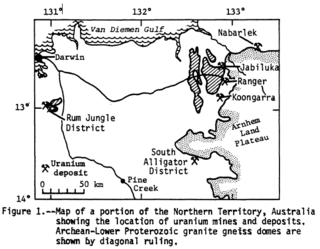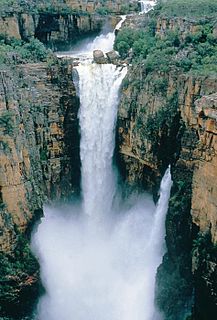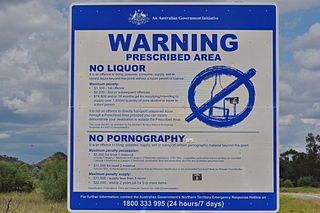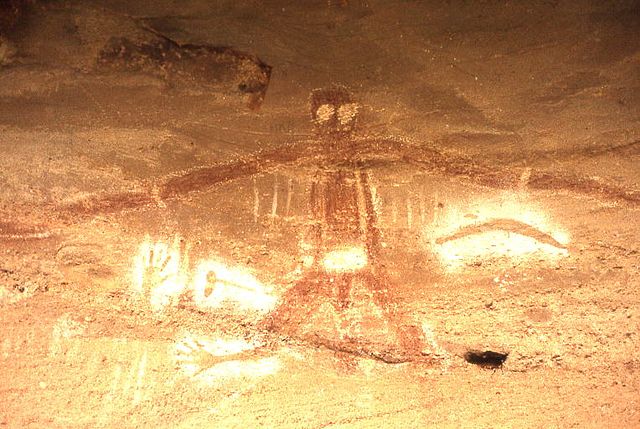
Protected areas of Australia include Commonwealth and off-shore protected areas managed by the Australian government, as well as protected areas within each of the six states of Australia and two self-governing territories, the Australian Capital Territory and the Northern Territory, which are managed by the eight state and territory governments.

Kakadu National Park is a protected area in the Northern Territory of Australia, 171 km southeast of Darwin.
Native title is the designation given to the common law doctrine of Aboriginal title in Australia, which is "the recognition by Australian law that Aboriginal people have rights and interests to their land that come from their traditional laws and customs". The concept recognises that in certain cases there was and is a continued beneficial legal interest in land held by local Aboriginal Australians which survived the acquisition of radical title to the land by the Crown at the time of sovereignty. Native title can co-exist with non-Aboriginal proprietary rights and in some cases different Aboriginal groups can exercise their native title over the same land.

The Aboriginal Land Rights Act 1976 provides the basis upon which Aboriginal people in the Northern Territory can claim rights to land based on traditional occupation. The Act was strongly based on the recommendations of Justice Woodward, who chaired the Aboriginal Land Rights Commission. The Labor government under Gough Whitlam first introduced a land rights Bill to Parliament; however, this lapsed upon the dismissal of the government in 1975. The Liberal government, led by Malcolm Fraser, reintroduced a different Bill in which details differed, and this was signed by the Governor-General of Australia on 16 December 1976.

The second part of the 1967 Australian referendum related to Aboriginal people. The 1967 Australian referendum, called by the Holt Government on 27 May 1967, consisted of two parts, with the first question relating to Aboriginal Australians. It asked for approval for two amendments to the Australian constitution based on this second question. The amendments related to counting Aboriginal people in the Australian census, and allowing the government to legislate separately for Aboriginal people. Technically this referendum question was a vote on the Constitution Alteration (Aboriginals) Act 1967, which became law on 10 August 1967 following the results of the referendum.

Commonwealth v Tasmania was a significant Australian court case, decided in the High Court of Australia on 1 July 1983. The case was a landmark decision in Australian constitutional law, and was a significant moment in the history of conservation in Australia. The case centred on the proposed construction of a hydro-electric dam on the Gordon River in Tasmania, which was supported by the Tasmanian government, but opposed by the Australian federal government and environmental groups.

The Willandra Lakes Region is a World Heritage Site in the Far West region of New South Wales, Australia. The Willandra Lakes Region is the traditional meeting place of the Muthi Muthi, Nyiampaar and Barkinji Aboriginal tribes. The 240,000-hectare (590,000-acre) area was inscribed on the World Heritage List at the 5th Session of the World Heritage Committee in 1981.
The law of Australia comprises many levels of codified and uncodified forms of law. These include the Australian Constitution, legislation enacted by the Federal Parliament and the parliaments of the states and territories of Australia, regulations promulgated by the Executive, and the common law of Australia arising from the decisions of judges.

Alligator Rivers is the name of an area in an Arnhem Land region of the Northern Territory of Australia, containing three rivers, the East, West, and South Alligator Rivers. It is regarded as one of the richest biological regions in Australia, with part of the region in the Kakadu National Park. It is an Important Bird Area (IBA), lying to the east of the Adelaide and Mary River Floodplains IBA. It also contains mineral deposits, especially uranium, and the Ranger Uranium Mine is located there. The area is also rich in Australian Aboriginal art, with 1500 sites. The Kakadu National Park is one of the few World Heritage sites on the list because of both its natural and human heritage values. They were explored by Lieutenant Phillip Parker King in 1820, who named them in the mistaken belief that the crocodiles in the estuaries were alligators.

The Native Title Act 1993 is a law passed by the Australian Parliament, the purpose of which is "to provide a national system for the recognition and protection of native title and for its co-existence with the national land management system". The Act was passed by the Keating Government following the High Court's decision in Mabo v Queensland (1992). The Act commenced operation on 1 January 1994.
Australian Aboriginal culture includes a number of practices and ceremonies centered on a belief in the Dreamtime and other mythology. Reverence and respect for the land and oral traditions are emphasised. Language and other groupings exhibit a range of individual cultures. Australian Aboriginal art has existed for thousands of years and ranges from ancient rock art to modern watercolour landscapes. Aboriginal music has developed a number of unique instruments. Contemporary Australian Aboriginal music spans many genres. Aboriginal peoples did not develop a system of writing before colonisation, but there was a huge variety of languages, including sign languages.

Kakadu National Park, located in the Northern Territory of Australia, possesses within its boundaries a number of large uranium deposits. The uranium is legally owned by the Australian Government, and is sold internationally, having a large effect on the Australian economy. The mining has been controversial, due to the widespread publicity regarding the potential danger of nuclear power and uranium mining, as well as because of objections by some indigenous groups. This controversy is significant because it involves a number of important political issues in Australia: Native Title, the environment, and Federal-State-Territory relations.

The Jim Jim Falls is a plunge waterfall on the Jim Jim Creek that descends over the Arnhem Land escarpment within the UNESCO World Heritage–listed Kakadu National Park in the Northern Territory of Australia. The Jim Jim Falls area is registered on the Australian National Heritage List.

The Northern Territory National Emergency Response, also known as "The Intervention" and sometimes the abbreviation "NTER" began with a media release by Mal Brough, Minister for Indigenous Affairs on 21 June 2007. The media release served as ministerial regulation to implement a taskforce of eminent Australians, led by Magistrate Sue Gordon, chair of the National Indigenous Council. The role of the Taskforce was to oversee a list of at least 12 measures in the Northern Territory, which included discriminatory changes to welfare, compulsory health checks for all Aboriginal children, the acquisition of Aboriginal townships, and banning alcohol and pornography in prescribed Aboriginal communities. The measures also included increased policing with assistance from other jurisdictions; calling in the army for logistics and surveillance; appointing managers to all government business in designated communities; and improving housing, but establishing market-based rents for public housing.
Australian heritage laws exist at the National (Commonwealth) level, and at each of Australian Capital Territory, New South Wales, Northern Territory, Queensland, South Australia, Tasmania, Victoria, Western Australia State and Territory levels. Generally there are separate laws governing Aboriginal cultural heritage and historical heritage. State laws also allow heritage to be protected through Local Government regulations, such as planning schemes, as well.
The Aboriginal Heritage Act 1988 is the principal South Australian legislation protecting and preserving the state's Aboriginal heritage.
George Jiří Chaloupka OAM, FAHA was an expert on Indigenous Australian rock art. He identified and documented thousands of rock art sites. As a result of Chaloupka's work on the sites, a new "definitive chronological sequence to these paintings was developed". Providing evidence that Indigenous people had occupied the land for much longer than what was previously accepted by the academic community.
Aboriginal land rights in Australia are return of lands to Aboriginal Australians by the Commonwealth, state or territory governments of Australia based on recognition of dispossession. Different types of land rights laws exist in Australia, allowing for the renewed ownership of land to Aboriginals [Aboriginal Australians] under various conditions. Land rights schemes are in place in the Northern Territory, Queensland, New South Wales, South Australia, Victoria and Tasmania. The land titles may recognise traditional interest in the land and protect those interests by giving Aboriginal people legal ownership of that land. Plus:
An Aboriginal reserve, also called simply reserve, was a government-run settlement for Aboriginal Australians, created under various state and federal legislation. Along with missions and other institutions, they were used from the 19th century to the 1960s to keep Aboriginal people separate from the white Australian population, for various reasons perceived by the government of the day. The Aboriginal reserve laws gave governments much power over all aspects of Aboriginal people’s lives.

John Flynn's Grave Historical Reserve, more commonly referred to as Flynn's Grave is the grave site of John Flynn who was an Australian Presbyterian minister who founded the Australian Inland Mission (AIM) and founding the Royal Flying Doctor Service. The grave, which is now a historical reserve, is located at the base of Mount Gillen on Larapinta Drive in the Alice Springs suburb of Flynn.











